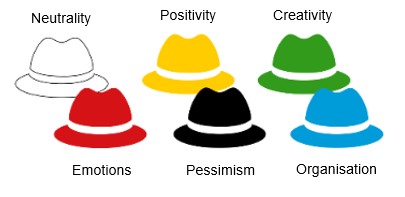have you ever heard about the 6 thinking hats method ?
Are you aware of its efficiency when using it in project development ?
The 6 thinking hats approach has been created by Mr. Edward de Bono, doctor in medecine and physician, among other titles. Although he has a rich background, he is especially well-known for his theory on lateral thinking, the topic of this article.

Very similar to the 3 Disney chairs, this method enable to develop all the various perspectives on a defined topic, and avoid any unproductive arguments between colleagues with different opinions. In other words, The participants analyse all the different point of views on a project, to then determine if it is really applicable. One of the advantages here is that people need to work collaboratively, gathering each other’s expertise and thoughts, which leads to a more consolidated project. This also encourages team building. Keep in mind however that as during any other Brainstorming technique, this one require the respect of certain general rules.
How does it work ?
To start with, have 6 hats of different color. Those colors have each a deeper meaning, allowing to better give diverse visions on a defined idea (don’t worry, you can use images of colorful hats rather than spending money on actual ones). After that, arrange the 6 pictures on the tables and make small groups. Each team will have to “wear” the 6 hats, with the aim of creating as many opinions as possible. To simplify this explanation, let’s analyse the following picture :

As you can see, a name / role is given for each color (or hat). It means that you need to develop opinions aligned with the role / hat you have. We will now go through each hat to better understand what is its role.
- White hat : this one represents a neutral and objective point of view. Otherwise speaking, you should give perspectives based on existing data, without any judgement. Remember however that here you share opinions and not actual facts.
- Red hat : in the contrary to the white hat, here the goal is to bring your own opinions, based on your emotions, intuition and judgement. No negative feedback should be made from other members of the team on what the person thinks. As during any step, you want each candidate to express themselves freely.
- Black hat : this time, give negative opinions. Share with others why you believe the project is not promising, show all the problems you think will interfere and the project from being successful.
- Yellow hat : oppositely to the black hat, this one brings out all the positive aspects of the idea. It means that you show motivation at this time and give the reasons why you believe so much in the project, why it will be a real success. On the other hand, stay down-to-earth, being positive does not mean being incoherent with your statements.
- Green hat : here, be imaginative. You need to find creative alternatives helpful to answer the define problem. To validate the detected solutions, you can go through the black and yellow hats.
- Blue hat : we can call it the disciplinary hat. The person given this role should mainly supervise the whole session. In other words, this supervisor is in charge of defining the problem and the context of the exercise, or also the objectives that need to be achieved. He should also determine which are the retained ideas and make a statement of the project progress.
Important
When applying the 6 thinking hats method, remember to communicate simply. This means you need to guide de candidates by mentioning the color of the hats and not their emotional equivalent. For instance, if you ask someone to wear a yellow hat, they will be able to think and act as the role they are given. Elseways, if you ask to wear the hat in order to be positive, it is much more difficult to act as such.
Finally don’t forget, if you want you project to be successful, wear more than one hat !